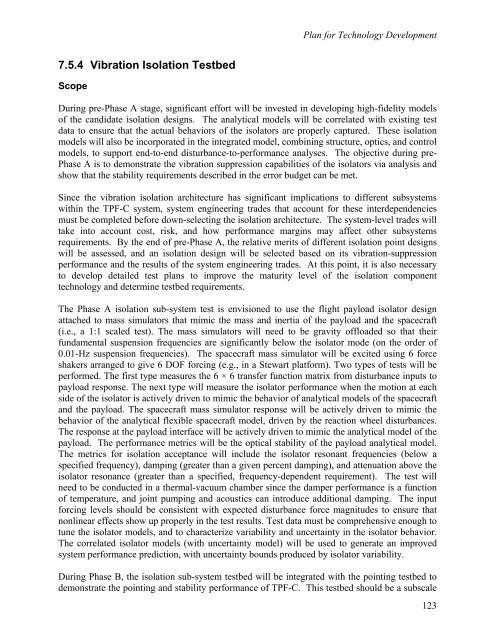TPF-C Technology Plan - Exoplanet Exploration Program - NASA
TPF-C Technology Plan - Exoplanet Exploration Program - NASA
TPF-C Technology Plan - Exoplanet Exploration Program - NASA
Create successful ePaper yourself
Turn your PDF publications into a flip-book with our unique Google optimized e-Paper software.
<strong>Plan</strong> for <strong>Technology</strong> Development<br />
7.5.4 Vibration Isolation Testbed<br />
Scope<br />
During pre-Phase A stage, significant effort will be invested in developing high-fidelity models<br />
of the candidate isolation designs. The analytical models will be correlated with existing test<br />
data to ensure that the actual behaviors of the isolators are properly captured. These isolation<br />
models will also be incorporated in the integrated model, combining structure, optics, and control<br />
models, to support end-to-end disturbance-to-performance analyses. The objective during pre-<br />
Phase A is to demonstrate the vibration suppression capabilities of the isolators via analysis and<br />
show that the stability requirements described in the error budget can be met.<br />
Since the vibration isolation architecture has significant implications to different subsystems<br />
within the <strong>TPF</strong>-C system, system engineering trades that account for these interdependencies<br />
must be completed before down-selecting the isolation architecture. The system-level trades will<br />
take into account cost, risk, and how performance margins may affect other subsystems<br />
requirements. By the end of pre-Phase A, the relative merits of different isolation point designs<br />
will be assessed, and an isolation design will be selected based on its vibration-suppression<br />
performance and the results of the system engineering trades. At this point, it is also necessary<br />
to develop detailed test plans to improve the maturity level of the isolation component<br />
technology and determine testbed requirements.<br />
The Phase A isolation sub-system test is envisioned to use the flight payload isolator design<br />
attached to mass simulators that mimic the mass and inertia of the payload and the spacecraft<br />
(i.e., a 1:1 scaled test). The mass simulators will need to be gravity offloaded so that their<br />
fundamental suspension frequencies are significantly below the isolator mode (on the order of<br />
0.01-Hz suspension frequencies). The spacecraft mass simulator will be excited using 6 force<br />
shakers arranged to give 6 DOF forcing (e.g., in a Stewart platform). Two types of tests will be<br />
performed. The first type measures the 6 × 6 transfer function matrix from disturbance inputs to<br />
payload response. The next type will measure the isolator performance when the motion at each<br />
side of the isolator is actively driven to mimic the behavior of analytical models of the spacecraft<br />
and the payload. The spacecraft mass simulator response will be actively driven to mimic the<br />
behavior of the analytical flexible spacecraft model, driven by the reaction wheel disturbances.<br />
The response at the payload interface will be actively driven to mimic the analytical model of the<br />
payload. The performance metrics will be the optical stability of the payload analytical model.<br />
The metrics for isolation acceptance will include the isolator resonant frequencies (below a<br />
specified frequency), damping (greater than a given percent damping), and attenuation above the<br />
isolator resonance (greater than a specified, frequency-dependent requirement). The test will<br />
need to be conducted in a thermal-vacuum chamber since the damper performance is a function<br />
of temperature, and joint pumping and acoustics can introduce additional damping. The input<br />
forcing levels should be consistent with expected disturbance force magnitudes to ensure that<br />
nonlinear effects show up properly in the test results. Test data must be comprehensive enough to<br />
tune the isolator models, and to characterize variability and uncertainty in the isolator behavior.<br />
The correlated isolator models (with uncertainty model) will be used to generate an improved<br />
system performance prediction, with uncertainty bounds produced by isolator variability.<br />
During Phase B, the isolation sub-system testbed will be integrated with the pointing testbed to<br />
demonstrate the pointing and stability performance of <strong>TPF</strong>-C. This testbed should be a subscale<br />
123
















